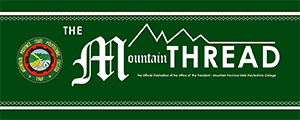SUPPLY CHAIN MANAGEMENT OF TEXTILE WOVEN PRODUCTS IN MOUNTAIN PROVINCE
Jayson Eming Imatong
ABSTRACT
This research described and analyzed the supply chain of the textile products in Mountain Province specifically on the status of the present supply chain management of the Mountain Province textile industry in terms of procurement, manufacturing, and distribution; and the strengths, weaknesses opportunities and threats in the supply chain. Further, this study included policy recommendations to improve the commodity industry in general and the specific supply chain in particular. The respondents were the major players in the textile industry of Mountain Province with registered firms whose activities are related to the textile industry.
This study made use of the descriptive qualitative design to meet its objectives. It particularly used the case study approach. The study was conducted in Mountain Province of the Cordillera Administrative Region. Study areas are the municipalities of Sagada and Bontoc. All the ten municipalities of the province are engaged in weaving, however, the two areas were selected on the basis of their having sustained markets of the registered firms engaged in the production of commercial textile products. The research locations followed the geographic flow of the woven products from the major sources to the major market destinations.
Results show that the local native textile industry has a complex supply chain structure. Even though the structure of supply chain is complicated, the links of the supply chain is independently separated and the communication among the players is carried out as needed without any particular formal method. All of the respondents believe that the quality of their products is their strength because of the uniqueness of the ethnic designs of the region. However, as identified by the respondents, there are impediments for growth such as distance of the suppliers that add to the cost of the end product; lack of capabilities in producing large volume of textile woven products; lack of finance; non-introduction of effective technology and the limitation on product diversity due to the type of textile produced. Although the export of woven textile from the province is yet to figure prominently, the potential for growth of the industry is immense especially in the dynamic fashion field; rising demand and usage of woven textile in the fashion industry; developing domestic and international tourism sector; emergence of internet; and potential source of foreign revenue. The local woven textile business has the following threats which are income reducing and have the potential to cause unemployment: the products have to compete on price, design and adaptability with modern machine made products which cause difficulties for our traditional products to be competitive in international market.
Based on these factors, the respondents expressed the need for government policy intervention that will focus on solutions which can maximize producers’ sales, improve quality of products and use updated technologies without depriving the final products of their local identities or heritage. Policy interventions can include developing a training course, patenting assistance, improvement of employee benefits and new market assistance.
Based on the abovementioned results, the researcher recommends for a conglomeration of the businesses inclined to this type of business. This means that there is a need to come together in planning for strategies like outsourcing labor among them to widen the market and yet be able to meet the needs of a bigger market. With a formal organization, they can have a stronger voice to go before government agencies for funding requests. In addition, there is a need for the creation of design development center for the production of new products and product diversification. Craftsmen need to be trained for better performance. Innovation and technology should be provided for overall development of the sector. Lastly, the researcher recommends that when the woven textile business owners form an association, they should include in their priorities a dialogue with and a proposal to concerned Local Government Units on the creation or inclusion of policies that will protect the welfare of this type of business. The policy recommendations should include regular training courses for the local players, labor sector involvement, patenting and market assistance. This focus is a hopeful solution that would maximize producers’ sales, improve quality of products and use updated technologies without depriving the final products of their local identities or heritage.





















